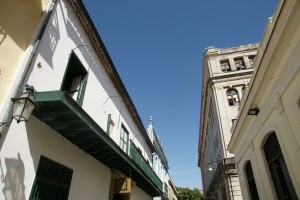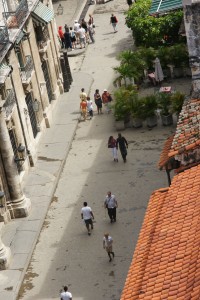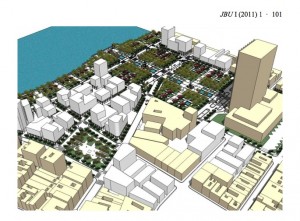Havana Going Forward
May 4, 2012 by admin
Today, Cuba faces (once again) a critical new horizon. The extreme poverty of the Special Period, after the collapse of the Soviet Union in the early 90s, has been mitigated to a degree. Progressive new conceptions of collectivity, as well as selective liberalizations to the economy, have already begun to radically transform the country. In particular, tourism has proven itself a major resource-generator, and has already changed the everyday experience of the capital and other cities. For example, recent renewal projects have given a facelift to parts of Old Havana. Fresh paint and thriving small private businesses have helped create a lively ambience for a particular public. While the inhabitants of these buildings have certainly benefited, these renovations seem to be catered to the masses of tourists who are funneled in large Chinese buses to particular “heritage sites” and other landmarks. They serve as a backdrop, helping to frame a singular image of that especially photogenic city. Juxtaposed with decay, these beautiful old buildings leave the traveler trembling in the face of the physical materialization of that forgotten dream of the picturesque. But other realities belie singular images; as has already been suggested, all urbanization projects are political.
While on a tour with a representative from Havana’s preservation and planning agency, we were able to remark at the scope and care with which Old Havana has been restored. Deeply aware of its historical significance, skilled architects, urbanists and historians researched every aspect of their work, down to restoring original paint colors. The representative noted the difficulty of the project, particularly when considering the economic ramification of the embargo and the Special Period. But the work has also benefited from these conditions; Havana did not experience either the modernist urban renewal projects that ravaged cities worldwide (such as in New York under Robert Moses), or the large-scale developments that occurred with the cyclical boom periods of late capitalism. Additionally, in 1982 Old Havana and its fortifications were named UNESCO World Heritage sites. The UNESCO website states:
“Despite its turbulent history, the city suffered little damage in the country’s wars and revolutions, and stands today much as it was built 100 years ago or more. It is today a sprawling metropolis of 2 million inhabitants, its old centre retaining an interesting mix of Baroque and neoclassical monuments, and a homogeneous ensemble of private houses with arcades, balconies, wrought-iron gates and internal courtyards.”
With this status, Havana has benefited financially and politically.

Havana is a UNESCO World Heritage Site
Similar renewal and revitalization efforts have been slated for the historic Malecón, which serves as a porous membrane between Havana and the sea. The street is at once a major thoroughfare; a promenade for flâneurs and lovers; a substantial resource for food and money for fishermen; and, an access point into the sea, which is deeply imbued with religious and cultural meaning for many Cubans. While in the city, we heard anecdotes from Santeria practitioners of the importance of the ocean. For example, one man I encountered explained that the ocean is an orisha, or spirit, with whom one can communicate. This limited and partial glimpse at the meanings embedded into this public space by the multitudes that experience it reveals the complexity necessary for an urban renewal project that aimed to be truly sensitive to the nature of the place.
Julio César Pérez Hernández, a Cuban architect and urban planner/designer, published A Vision for the Future of Havana, a proposed master plan for the city. Hernández begins with a thorough, if opinion laden, history of Havana’s development. In particular, he mourns the abandoning of mixed-use areas in the 1920s for American-style sprawl designed around the automobile. Similarly, he asserts that the switch of government focus from urban areas to rural areas following the Revolution contributed to the sprawling growth of the city. He mourns the “incompatibility” of the Soviet-style apartment towers and the “loss of the traditional grid.” Finally, he denigrates the foreign investments of the 1980s and 1990s for their ignoring of sustainable or regionally-sensitive architecture in favor of an air-conditioned “hostile environment devoid of a recognizable spirit of place.”
Hernández writes:
“A team of Cuban architects, led by this author, has designed a Master Plan aimed at preserving the city’s spirit and its historic, urban and architectural legacy, while encouraging its future urban and economic development. The urban plan expresses a holistic vision that is independent from the government’s ideas and from the official planning agencies that replicate the official mandate. It looks toward Havana’s future while remaining true to its history, its people’s idiosyncrasies and its landscapes. For the first time, it provides a comprehensive scope, spanning both urban planning and urban design, in such a way as to give continuity to Havana’s traditions and to seek a contemporary image.”
In his plan, he names ten key concepts: defining the city’s “image” through waterfront revitalization; “reinforcing” the city’s “polycentric structure” to assert its “identity”; increasing public space; new public transportation systems; upgrading infrastructure; mix-use development; “social and cultural integration”; redeveloping the traditional Calzadas; increasing greenery; and urban infill.
While particularly sensitive to ecological issues, his plan contradicts its intention almost immediately. By claiming the waterfront as the city’s “image,” the project would further the negative ramifications of earlier projects in Old Havana that make claim to a single part of the city being the “authentic Havana” and, theoretically, displacing other parts of the city as “inauthentic.” Hernández’s stated dislike for certain aspects of development, while understandable considering contemporary aesthetic preference, posits certain historical periods as better than others. This ignores the everyday use of the city, for even in the large Soviet towers and the “hostile environments” of new developments, individuals act out their lives, imbue places with meaning, and creatively interact with their environment. Hernández’s type of thinking parallels the pre-Revolutionary sentiment that privileged urban areas over rural areas, and suggests a perspective that is locked in its singularity. Likewise, his perspective suggests the fixed images of photographs or aerial maps, and this can be read in his diagrams.
Hernández’s usage of ambiguous concepts such as “identity,” “image,” and “social and cultural integration” within a master plan suggest an assumption of authority. The belief that a singular urban planner or firm could understand the “identity” of a city assumes that it is possible to fix the sentiments of a multiplicity of individuals. This is, of course, impossible; but urbanists can endeavor to implicate as many people as possible to mitigate the dangers inherent in such projects. Hernández does not seem to do so, but rather assumes he has made an “authentic” reading of the city and thus can formulate a future for it. This is typical of architects, like him, involved in the International Network for Traditional Building, Architecture, and Urbanism, a group started by the Prince of Wales that attempts to preserve and replicate traditional building practices. While noble in their efforts to mitigate unfettered developments, they often elevate a particular morphology or aesthetic as “authentic,” crafting a nostalgized picture of a romanticized past. While their aesthetics are often different, such architects seem to follow in the megalomaniac approach of the same urbanists they condemn, like the modernist Luis Sert.
Sources:
http://whc.unesco.org/en/list/204
http://www.journalofbiourbanism.org/wp-content/uploads/2012/01/JBU1_R_93-102.pdf
http://www.intbau.org/
Leave a Reply
You must be logged in to post a comment.




